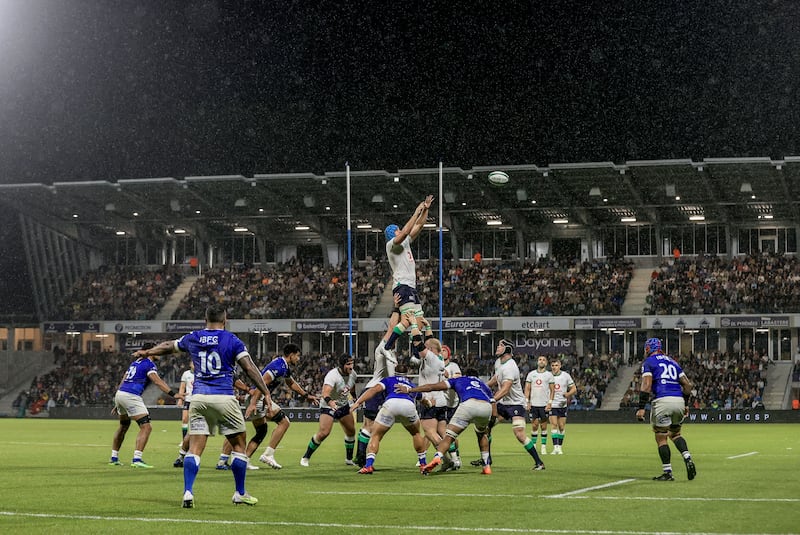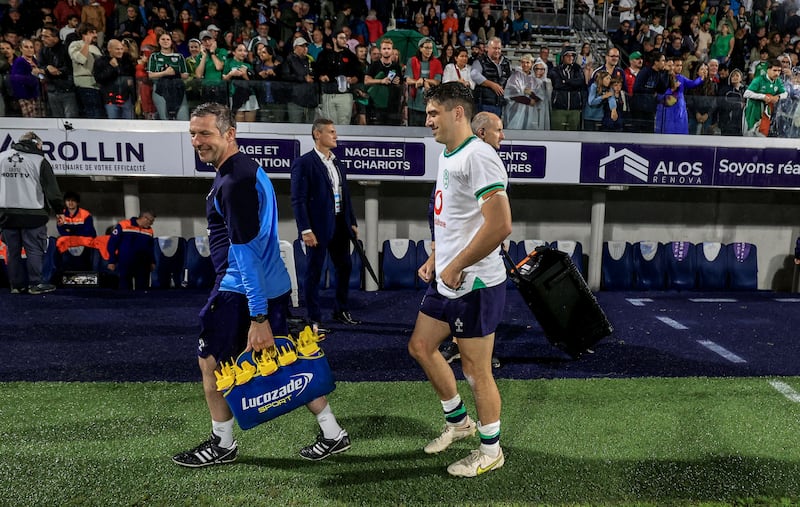Penny for the thoughts of Jimmy O’Brien as he looked out at the teeming rain in Bayonne on Saturday evening knowing that there would be no respite in the weather come kick-off time in Ireland’s final World Cup warm-up match against Samoa.
The 26-year-old Kildare native had been tasked to step up as the Dauphin in Hugo Keenan’s 15 jersey on a filthy French night, winning his seventh cap, three of which, including the Samoan assignment, were starts at fullback.
O’Brien is an excellent footballer who can play across a backline, an outhalf in his schooldays, and since then he’s worn every number from 10 to 15 in his senior career, but that versatility comes with a hefty tariff. There is a great deal of devilled detail to be consumed when a player is covering a handful of positions. He’s done remarkably well to be so adept to this point in his career.
Keenan’s metronomic excellence, his work ethic, positional play, aerial solidity, lines of running, spatial awareness, defending, footwork, speed and kicking game casts a long shadow for anyone challenged to deputise. It’d be a tough remit in balmy conditions but the elements – the rain, the greasy ball and the sodden surface – added a multiplier effect in difficulty terms.
READ MORE
There were other unforeseen complications too on the night. Ireland’s general performance was knocked out of kilter by the physically aggressive Samoans, who ran hard, and in defence boasted a bristling aggression and speed underpinned by an unquenchable thirst for collisions; they won the gain-line battle on both sides of the ball for large tranches of the contest.
Samoa destabilised Ireland’s set piece in the opening 50 minutes, turning over five lineouts and winning two scrum penalties and unpicking the ragged seams in Ireland’s performance. As a result, Andy Farrell’s side lacked composure and cohesion with the game plan sacrificed on the altar of personal errors.

The adage that the collective must function for the individual to shine in a team context was very evident on the night. Ireland could not get a rhythm until a glut of frontline players arrived in the nick of time to provide direction; even then Farrell’s side came perilously close to losing.
Players crave an early positive touch that helps the settling process, but few Irish players were afforded that luxury in a harum-scarum opening to the context. O’Brien was caught in the maelstrom, inadvertently at times.
Mack Hansen’s blocked down kick and Jack Crowley’s one-handed flick left O’Brien having to reach to rescue the ball over his head and he knocked on as a posse of Samoans converged. On six minutes the Irish fullback had reason to be grateful to Conor Murray and Stu McCloskey who bundled Samoa’s right wing, Ed Fidow, into touch a couple of metres from the line.
O’Brien was charged with making that tackle initially but as he galloped across to take the last man, he got his timing and technique wrong and was bounced in contact. He recovered from those setbacks to grab his first try in Test rugby on eight minutes, running an intelligent support line and taking Mack Hansen’s unselfish pass to dot down.
Bundled into touch by three Samoans while tidying up a grubber kick, O’Brien forced a fumbled knock-on when chasing his own Garryowen minutes later. He was quickly appraised of the difficulty of being on the receiving end of a high-ball assault, Samoa’s former All Black Lima Sopoaga’s pinpoint kicking causing problems for several Irish players in the backfield.
It wasn’t just a case of fielding the ball but protecting it in the subsequent contact; twice O’Brien came down with the ball and on both occasions he had it knocked from his grasp in the ensuing tackle. On the flip side, he pulled off one or two good catches, well positioned and composed while also offering a fine left-footed kicking option on a couple of occasions.

On 34 minutes, he offered a glimpse of his footwork and balance, grabbing a ball from the air, sidestepping the first tackler and occupying two more Samoans before being brought to ground well beyond the gainline.
O’Brien will have been a little disappointed with his next contribution, slightly tentative in coming forward with the result that a high ball spilled forward. Seven minutes into the second half he received a painful reminder that running headlong into contact without footwork against two Samoan forwards is both brave and painful.
He took a dunt to his clavicle and although he played on after treatment for a further five minutes he was summoned to the sideline. Every minute in Test rugby as a starting player is invaluable for those with an aptitude to learn and evolve.
Some of his periodic discomfort came from the general malaise of playing in a team that underperformed, while on other occasions he’ll know he needs to do better. That’s the challenge, don’t get engulfed when the team misfires.
Opportunity will arise on his return to France, probably in one of the first two World Cup pool matches, when his progress will be measured again using Keenan as a coefficient.
















